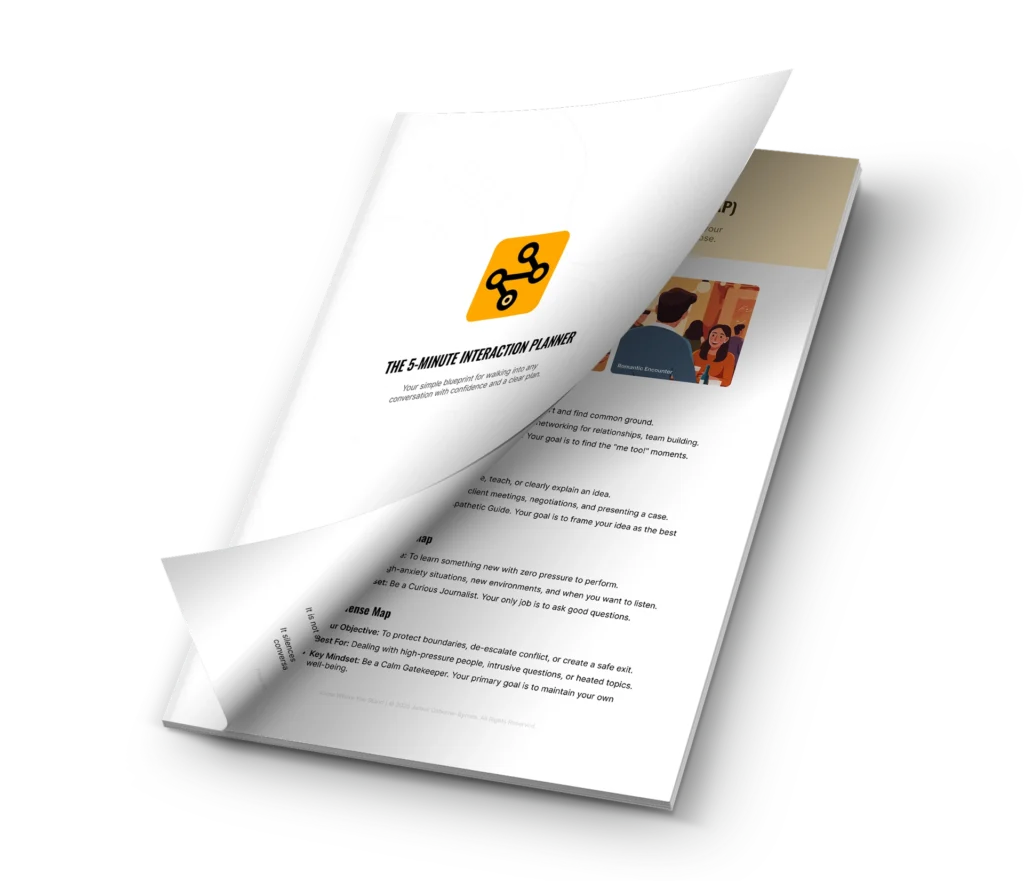You’re in a conversation. The words are normal, even friendly, but a knot forms in your stomach. This is a classic gut feeling about people, a sense of unease you can’t quite name. You’ve been taught to dismiss this feeling as paranoia or overthinking.
But what if that gut feeling isn’t paranoia? What if it’s the most accurate data-detection system you own?
That feeling is a real, biological signal. To understand it, we need to uncover the two conversations happening in every interaction. One is audible, but the other one frequently holds the truth. A Navigator learns how to hear both.
Understanding the two conversations
Your intuition is so frequently right because in every human interaction, there isn’t one conversation happening, but two.
The audible conversation (the words)
This is the surface level. It’s the literal meaning of the words someone speaks, the official story, the logical narrative. Operating only on this level is what we call the Drifter’s mindset, hearing the words but missing the real story.
The other conversation (the truth)
This is the revealing undercurrent of intent, emotion, and subtext. It’s where the truth usually lives. This conversation uses the silent language of nonverbal communication, including body language, facial expressions, and tone of voice.
- Body Language: Notice the posture, crossed arms, tense shoulders, or if a person is leaning in or away.
- Facial Expressions: Look for micro-expressions, a slight frown, a forced smile, or a lack of eye contact.
- Tone of Voice: Listen for clipped speech, a flat or hesitant voice, or an overly enthusiastic pitch. This is where you find the subtext in communication.
Where your gut feeling about people comes from
Your gut feeling is a biological alarm. It rings when your brain detects a conflict between the Audible Conversation and the Other Conversation.
The words say one thing, but the non-verbals scream another. This conflict is why you feel something is off. It is why you get a bad feeling about someone for no apparent reason.
Proof in action using the universal “I’m fine” test
Although this sounds abstract, you’ve seen this clash between the two conversations a thousand times. Consider this classic scenario.
You ask a friend who is upset, “What’s wrong?” and they reply through gritted teeth, “Nothing. I’m fine.”
Your brain instantly processes both sets of data.
- The Audible Conversation is direct. The words are “I’m fine.”
- The Other Conversation tells the real story. The clipped tone, the rigid posture, and the refusal to make eye contact are all pieces of conflicting data.
Someone in a Drifter state awkwardly accepts the words and moves on. An aware person understands that the data from the Other Conversation is the truth.
Your first mission to start trusting your intuition
Knowing this is one thing, but proving it to yourself is another. Here is a straightforward, low-stakes mission to train your perception and begin trusting your intuition.
Become a ‘signal spotter’
This week, your mission is not to act or confront, but to notice. You are training the muscle of awareness and proving to yourself that your intuition is a valid skill.
The goal is to spot one small moment where the words do not match the “music” behind them.
- A coworker agrees to a deadline with a heavy sigh and a slight eye roll.
- A friend says they’re “so excited” for a plan in a completely flat voice.
When you spot it, make a mental note. “There it is.” The victory is in the act of conscious noticing, not in the analysis.
The next time you get that gut feeling about people, remember you’re not being paranoid. You are listening to the more honest conversation. Learning to consciously see these two conversations is your first step from a passive Drifter state to becoming an aware Navigator in your life.
But what happens after the conversation ends? For many of us, these unresolved feelings fuel hours of overthinking. This comes at a steep price, a hidden fee we call The Anxiety Tax. We’ll show you how to stop paying it in our next post.
Your Next Step
You now understand the “Two Conversations” that your gut is picking up on. Let’s define the tangible cost of that unresolved uncertainty.
Continue Reading Part 4: The Art of Preparation and How to “Optimize” Your Approach →



